The Howler Monkeys are considered the largest New World monkeys and usually live in South and Central America. These animal species, with the broad side-opening nostrils, have the scientific name of Alouatta. They have average body lengths of about 28 inches and long prehensile tails of 23 to 36 inches.
In addition to this, howler monkey noise is also of great concern because these animals produce loudest sounds. They use these noises to send messages to each other. The walking speeds of these animals are slow and are known as the slow-moving monkeys that can live up to 15 to 20 years.
- Related: Rhesus Macaque
Howler Monkey
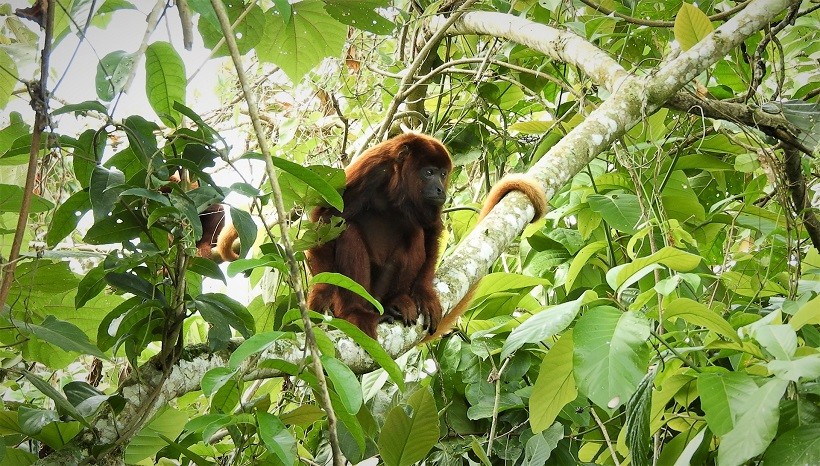
These animal species are of the largest sizes, having no pads on their rumps. Their loud noises can travel up to 2 to 3 miles and can be heard during rainstorms, dawn, and dusks. They are being caught to be used as zoo animals and pets. Their gestation period is about six months. The reproduction can occur at any time, thus producing single offspring. There are present different types of these primate species, but here, we are going to discuss only a few of them.
- Related: Emperor Tamarin
Black Howler Monkey
These largest monkeys with the scientific name of Alouatta caraya inhabit Northern Argentina, Southern Brazil, and Eastern Bolivia and Latin American rainforests. Their diet facts include the consumption of trees, vine leaves, tropical rain fruits, and flowers for survival. Furthermore, they live in groups containing 4 to 19 members.
Red Howler Monkey
This type of new world monkey is also called Colombian red Alouatta, which inhabits the tropical rainforests of Central and Southern America. Their scientific name is Alouatta seniculus. In addition to it, these howler monkey fun facts include that they live in groups containing 10 to 15 members, thus producing roaring sounds due to the presence of hyoid bone in their throats.
Venezuelan Red Howler
These animal species inhabit Ecuador, Brazil, Peru, Colombia, and Western Amazon Basin in Venezuela. They have a length of 28 inches and weigh 14 pounds only. The jawbones of these monkeys are large-sized. If we talk about howler monkey endangered species, they, although, are non-extinct but will soon become endangered due to habitat loss and hunting.
Mantled Howler
They are called so because of the presence of long-sized guard hair. They inhabit Costa Rica, Southern Guatemala, Veracruz, and Mexico. Alouatta palliata is their scientific name. The females weigh up to 8 pounds while the males weigh up to 20 pounds. Furthermore, the baby howler monkey facts include that the baby girl has a light brown-colored fur while baby boys have fur of black color.
Azuero Howler
These are the subspecies of Coiba Island howler A. Coiba Island and have the scientific name of Alouatta coibensis trabeata. They have brown-colored bodies. Their golden flanks and lions are very impressive. In addition to this, these primates show resemblance to Old World monkeys, apes, and humans.
Guatemalan Black Howler
These mammals with the scientific name of Alouatta pigra are the largest monkeys and inhabit Central America, Mexico, and Yucatan peninsula. They have long hair of black color. An enlarged hyoid bone is present near the vocal cords of males. The females become mature at the age of four years, while males reach the maturity level at the age of eight years.
Guyanan Howler
They have the scientific name of Alouatta macconnelli and are native to Venezuela, Brazil, Guyana, Trinidad, and Suriname. The males weigh about 17 pounds while females weigh 13 pounds. They have gold or bright orange-colored underparts. Furthermore, the thick beard of these selective-eater animals covers their wide jaws.
Bolivian Red Howler
These howler monkeys with the scientific name of Alouatta sara inhabit Bolivia, Brazil, and Peru. They weigh between 12 to 15 pounds having brick-red and orange-colored coating on their backs. They usually mate between wet seasons during the availability of nutritious food.
Purus Red Howler
These monkeys with the scientific name of Alouatta puruensis are widely distributed throughout Brazil, Bolivia, and Peru. Their tails are five times longer in size than their bodies. They feed on small birds, mammals, reptiles, fruits, and leaves.
Ursine Howler
They have the scientific name of Alouatta arctoidea and are considered the subspecies of Venezuelan howler monkeys. They are usually found in Colombia and Venezuela.
Coiba Island Howler
They have the scientific name of Alouatta Coiba Island and are native to Panama. The mitochondrial DNA testing has also been done to know whether these are the subspecies of mantled howlers or not. Instead of this, their dermal ridges of feet and hands make them different from the mantled ones.
Golden Howler Monkey
They are also known as black and gold howlers and inhabit Central and South America. Their prehensile tails work as an extra hand for them, thus helping them grip branches. The males have black-colored, while females have buff-colored bodies. Furthermore, if we talk about the howler monkey life cycle, they have a gestation period of 187 days and can live up to thirty years.
Amazon Black Howler
These monkeys are the primate species that live in Amazon rainforests. Alouatta nigerrima is their scientific name. The males produce much higher noises than females, which can be heard from about one mile away. They are also excellent swimmers.
Maranhão Red Handed Howler
These animal species with the scientific name of Alouatta ululata inhabit Maranhão, Piaui΄, Northern Brazilian states of Ceara΄and Babacu forests. They are considered strongly sexually dichromatic.
Spix’s Red-handed Howler
The Spix’s red-handed howlers with a back of reddish-brown and yellowish-brown color weigh between 12 to 16lbs. They have the scientific name of Alouatta discolor and inhabit southeastern Amazon in Brazil. In addition to this, they feed on ripe and unripe fruits, woody plant matter, flowers, and sometimes fungi for digesting the increased amount of plant matter.
Mexican Howler Monkey
These animal species having the scientific name of Alouatta palliata mexicana are the subspecies of mantled howler monkeys. They have large-sized pharynx and deep jaws and are found in Northeastern Peru and Southeastern Mexico. Furthermore, they live in groups containing a maximum of 40 members.
Howler Monkey Rescue
A Refuge for wildlife named “International Animal Rescue partner project” has been developed to rescue Costa Rica’s wildlife. These monkeys are also provided with proper diet and care at this refuge.
Howler Monkey Babies
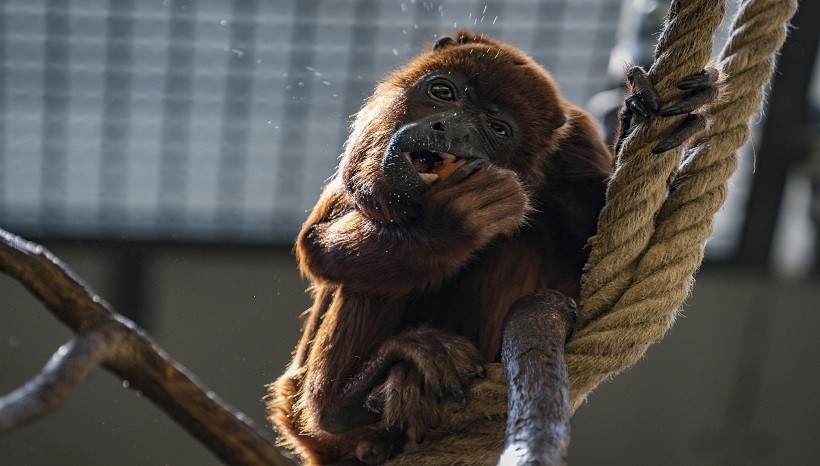
With a gestation period of six months, these mammals give birth to a single baby every two years. The howler monkey babies have light brown-colored bodies when they are born. The baby girls have fur of light brown color while the baby boys’ fur turns black at the age of three years. In addition to this, the females take great care of their newborn babies before considering mating with another male.
Baby Howler Monkey Facts
There are many exciting facts about these baby howler monkeys. For example, they use the fur of their mothers to get hidden and walk slowly. These little ones use nuts, flowers, and fruits for their survival.
Howler Monkey Sound
The howler monkeys are considered the loudest of all other Old World and New World monkeys. Their loud sounds can travel up to more than one mile and can be heard at the times of dawn and dusk. Their howling sound has the range between 128dB and 140dB, thus using them to alert the other members of their groups.
In addition to this, these animal species make a whooping call by holding their mouth wide open, and their baggy throat makes these louder sounds vibrating.
- Related: Mandrill vs Baboon
Howler Monkey Diet
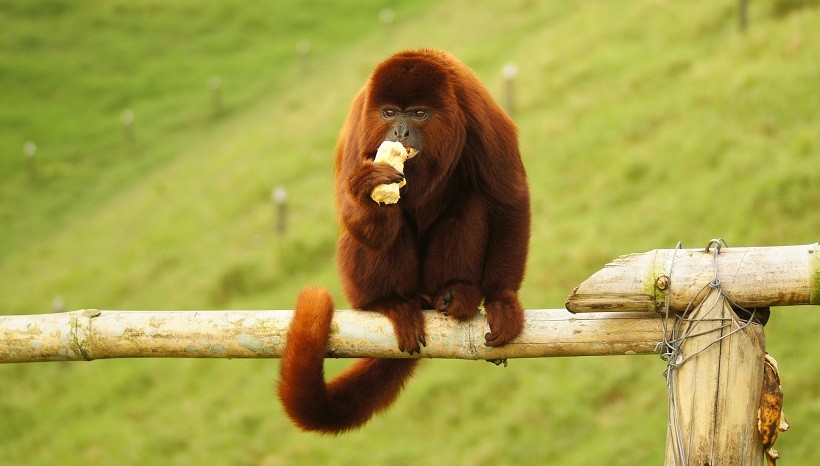
Like all other species, these animals also require a proper diet and care for their survival. These friendly monkeys use their extended prehensile tails for hanging on trees. As they are herbivores, they can eat both fruits and leaves, including flowers and nuts. They usually get the required water from the food they are eating.
Howler Monkey Balls
A U-shaped bone named hyoid bone present in their necks is the reason behind their roar. The animals with larger hyoid produce deeper sounds while those with smaller hyoids produce a shallow call.
In addition to this, these small-balled and deep-voiced monkeys live in groups having multiple females and single male while the large-balled and shallow-voiced ones live in groups with multiple males.
Howler Monkey Habitat
The howler monkey rainforest facts include that these mammals are found in the rainforests of Costa Rica, Ecuador, Brazil, Colombia, Southern, and Central America. As these animal species spend most of their time in the trees, they tend to live in the forests with a broad range of plant life.
Furthermore, they also inhabit mountain forests, lower elevations, and in the higher branches of trees. These monkeys move between the trees and come very rarely to the ground.
Howler Monkey Predators
The howler monkey predators include giant snakes, Pumas, Jaguars, and harpy eagles. They make louder noises to scare the predators and warn the other members of their groups. Their greatest threats include humans as well who use them for bush meat purposes.
Instead of all this, they sometimes kill each other to lower the population of their groups; this population is also decreasing day by day due to habitat loss.
- Related: Lion-tailed Macaque All Information
Howler Monkey Size
These animal species with roundish snout-type noises have sizes between 22 and 36 inches. Their prehensile tails are about five times larger than the body length and are used by them for gripping the branches of trees. In addition to this, these bearded monkeys are of different types depending upon colors and sizes.
Howler Monkey Fact
The facts about them include that they have a long prehensile tail, unlike other Old World monkeys, which they use as an extra arm. Their unique shell-like chambers and large throats help to make loud noises for sending messages to the members of other groups. They also look like bearded mammals because of the large-sized hair growth from their chins.
Howler Monkey Adaptations
Like other animals, these monkeys also have some unique features and adaptations; for example, the howler monkey behavioral adaptations include the use of dung piles for marking their territory. These species also have oversize vocal features, i.e. larynx, to produce loud noises and roar as loud as a lion.
Howler Monkey Information
There are present exciting information and facts about howler monkeys, i.e. their names come from the fact that they can produce howling sounds. These large-sized animals are not so swift and are known as slowly-moving mammals. In addition to this, they are socially very active, having complex hierarchy and three color-visions like other people. These animal species are also called folivores and mostly eat leaves.
Red Howler Monkey
These red Alouatta species with a length of 23 inches and a weight of 16 pounds are found near the western Amazon Basin in Colombia and Brazil. They are very friendly with each other and live in groups of 10 to 15 members. These animals are not so active, and their tails keep them safe from falling to the grounds.
Red Howler Monkey Diet
Their diet facts include that they are selective eaters avoiding the poisonous leaves and eat fruits, flowers, and leaves. They consume almost 60 percent of these leaves for survival.
Red Howler Monkey Facts
These howler monkeys’ facts include that their loud noises can be heard from about twenty miles and have a gestation period of about 190 days.
Black Howler Monkey
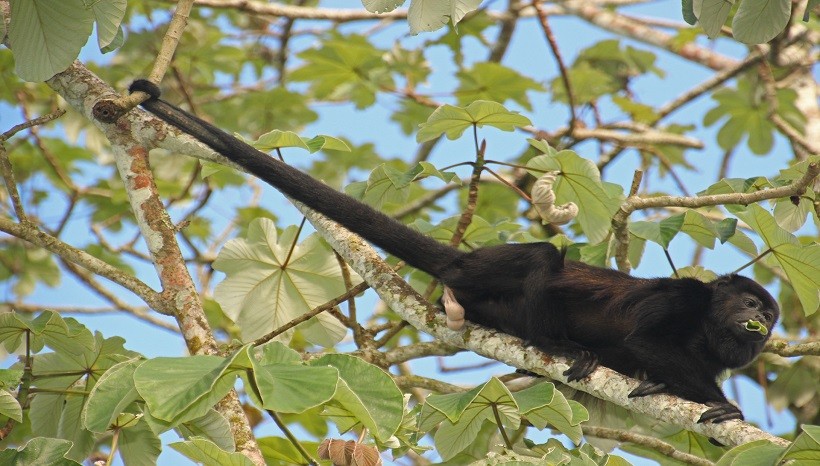
These animal species with an average length of 36 inches are widely distributed near Eastern and Western Brazil. They are herbivores having a gestation period of about 186 days. Their long prehensile tail functions as the fifth limb, allowing them to move between long branches of trees. Instead of this, they have a lifespan of about twenty years.
Black Howler Monkey Facts
The males become black-colored on reaching the maturity level while females with juveniles of yellowish or whitish-colored buff stay blonde the whole life.
Black Howler Monkey Facts for Kids
These howler monkey facts for kids include that they move with an average speed of 30 km/h. They howl every morning for giving signals to the neighboring group members about their location.
Brown Howler
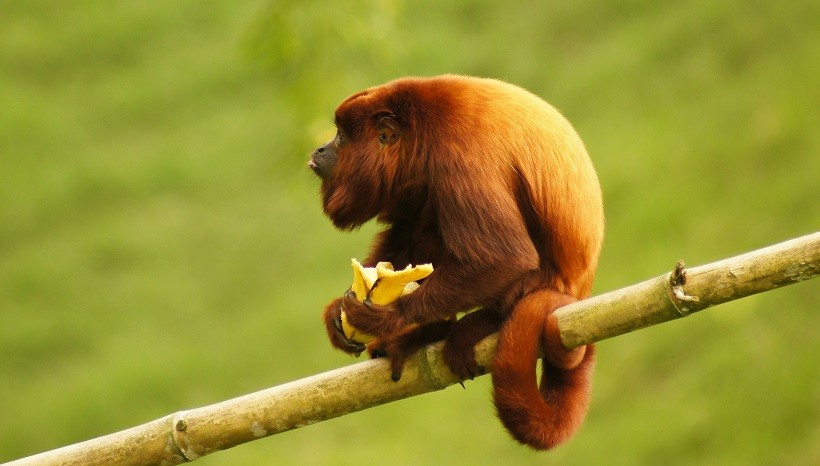
These animals, with the scientific name of Alouatta guariba, inhabit Northeastern Argentina and Southeastern Brazil. They weigh between 9 to 14 pounds and have an average length of 40 inches. These animals are herbivores and live in groups containing eleven members.
Northern Brown Howler
These primate species with auburn-colored fur coats inhabit Brazil and are folivores-frugivores. Furthermore, they weigh between 9.5 lbs to 14.8 lbs, having a lifespan of 15 to 20 years.
Southern Brown Howler
These monkeys with the scientific name of Alouatta guariba clamitans are found in Southeastern Brazil. They were first considered as separate species, but this was not accepted.
FAQ’s
Sometimes the people get confused even after knowing the exciting facts and information about these monkeys and raise some questions. So, the answers to some of those raised questions are as follows:
1. Are howler monkeys dangerous?
These animal species used to live in trees and are not so dangerous. They are very friendly, but sometimes cause great harm, if provoked.
2. Are howler monkeys aggressive?
These monkeys are of low temperament and sometimes get very aggressive. That’s why they are not considered a good option to be kept as pets.
3. Are howler monkeys friendly?
Yes, they are very friendly to each other and live in groups having 10 to 18 monkeys. But they sometimes kill each other to lower the group members’ population.
4. What eats a howler monkey?
Their predators include giant snakes, harpy eagles, humans, Pumas, and Jaguars. These predators and habitat loss are the primary reasons behind the decreasing population of these monkeys.
Conclusion
As we have discussed many exciting facts and information about these animal species, there are present some threats to them as well. For example, they are being hunted for bush meat purposes and are also eaten by other forest animals.
In addition to this, deforestation is the main cause of habitat loss, making their survival difficult. So, we must support those rehabilitation centers that are helping these howler monkey animal species and avoid their use for bush meat purposes.
if you want to learn more about pets visit us at petshoods
{ "@context": "https://schema.org", "@type": "Article", "mainEntityOfPage": { "@type": "WebPage", "@id": "https://petshoods.com/howler-monkey-facts-and-all-information/" }, "headline": "Howler Monkey Wildlife Info, Facts and All Information", "description": "Howler Monkeys are one of the largest monkeys in the New World. They are famous for their loud howls and weigh between 9 to 14 pounds and have an average length of 40 inches.", "image": "https://petshoods.com/wp-content/uploads/2020/07/Howler-Monkey-Wildlife-Info-Species-Habitat-Facts-and-All-Information.jpg", "author": { "@type": "Person", "name": "jeremy" }, "publisher": { "@type": "Organization", "name": "Petshoods", "logo": { "@type": "ImageObject", "url": "https://petshoods.com/wp-content/uploads/2019/02/13925402_1502331219793083_1620090286454245017_n.jpg" } }, "datePublished": "2020-07-21", "dateModified": "2021-07-14" } { "@context": "https://schema.org/", "@type": "ItemList", "itemListElement": [ { "@type": "ListItem", "position": 1, "name": "Howler Monkey", "url": "https://petshoods.com/howler-monkey-facts-and-all-information/#Howler_Monkey" }, { "@type": "ListItem", "position": 2, "name": "Black Howler Monkey", "url": "https://petshoods.com/howler-monkey-facts-and-all-information/#Black_Howler_Monkey" }, { "@type": "ListItem", "position": 3, "name": "Red Howler Monkey", "url": "https://petshoods.com/howler-monkey-facts-and-all-information/#Red_Howler_Monkey" }, { "@type": "ListItem", "position": 4, "name": "Venezuelan Red Howler", "url": "https://petshoods.com/howler-monkey-facts-and-all-information/#Venezuelan_Red_Howler" }, { "@type": "ListItem", "position": 5, "name": "Mantled Howler", "url": "https://petshoods.com/howler-monkey-facts-and-all-information/#Mantled_Howler" }, { "@type": "ListItem", "position": 6, "name": "Azuero Howler", "url": "https://petshoods.com/howler-monkey-facts-and-all-information/#Azuero_Howler" }, { "@type": "ListItem", "position": 7, "name": "Guatemalan Black Howler", "url": "https://petshoods.com/howler-monkey-facts-and-all-information/#Guatemalan_Black_Howler" }, { "@type": "ListItem", "position": 8, "name": "Guyanan Howler", "url": "https://petshoods.com/howler-monkey-facts-and-all-information/#Guyanan_Howler" }, { "@type": "ListItem", "position": 9, "name": "Bolivian Red Howler", "url": "https://petshoods.com/howler-monkey-facts-and-all-information/#Bolivian_Red_Howler" }, { "@type": "ListItem", "position": 10, "name": "Purus Red Howler", "url": "https://petshoods.com/howler-monkey-facts-and-all-information/#Purus_Red_Howler" }, { "@type": "ListItem", "position": 11, "name": "Ursine Howler", "url": "https://petshoods.com/howler-monkey-facts-and-all-information/#Ursine_Howler" }, { "@type": "ListItem", "position": 12, "name": "Coiba Island Howler", "url": "https://petshoods.com/howler-monkey-facts-and-all-information/#Coiba_Island_Howler" }, { "@type": "ListItem", "position": 13, "name": "Golden Howler Monkey", "url": "https://petshoods.com/howler-monkey-facts-and-all-information/#Golden_Howler_Monkey" }, { "@type": "ListItem", "position": 14, "name": "Amazon Black Howler", "url": "https://petshoods.com/howler-monkey-facts-and-all-information/#Amazon_Black_Howler" }, { "@type": "ListItem", "position": 15, "name": "Maranhao Red Handed Howler", "url": "https://petshoods.com/howler-monkey-facts-and-all-information/#Maranhao_Red_Handed_Howler" }, { "@type": "ListItem", "position": 16, "name": "Spixs Red handed Howler", "url": "https://petshoods.com/howler-monkey-facts-and-all-information/#Spixs_Red-handed_Howler" }, { "@type": "ListItem", "position": 17, "name": "Mexican Howler Monkey", "url": "https://petshoods.com/howler-monkey-facts-and-all-information/#Mexican_Howler_Monkey" }, { "@type": "ListItem", "position": 18, "name": "Howler Monkey Rescue", "url": "https://petshoods.com/howler-monkey-facts-and-all-information/#Howler_Monkey_Rescue" }, { "@type": "ListItem", "position": 19, "name": "Howler Monkey Babies", "url": "https://petshoods.com/howler-monkey-facts-and-all-information/#Howler_Monkey_Babies" }, { "@type": "ListItem", "position": 20, "name": "Howler Monkey Sound", "url": "https://petshoods.com/howler-monkey-facts-and-all-information/#Howler_Monkey_Sound" }, { "@type": "ListItem", "position": 21, "name": "Howler Monkey Diet", "url": "https://petshoods.com/howler-monkey-facts-and-all-information/#Howler_Monkey_Diet" }, { "@type": "ListItem", "position": 22, "name": "Howler Monkey Balls", "url": "https://petshoods.com/howler-monkey-facts-and-all-information/#Howler_Monkey_Balls" }, { "@type": "ListItem", "position": 23, "name": "Howler Monkey Habitat", "url": "https://petshoods.com/howler-monkey-facts-and-all-information/#Howler_Monkey_Habitat" }, { "@type": "ListItem", "position": 24, "name": "Howler Monkey Predators", "url": "https://petshoods.com/howler-monkey-facts-and-all-information/#Howler_Monkey_Predators" }, { "@type": "ListItem", "position": 25, "name": "Howler Monkey Size", "url": "https://petshoods.com/howler-monkey-facts-and-all-information/#Howler_Monkey_Size" }, { "@type": "ListItem", "position": 26, "name": "Howler Monkey Fact", "url": "https://petshoods.com/howler-monkey-facts-and-all-information/#Howler_Monkey_Fact" }, { "@type": "ListItem", "position": 27, "name": "Howler Monkey Adaptations", "url": "https://petshoods.com/howler-monkey-facts-and-all-information/#Howler_Monkey_Adaptations" }, { "@type": "ListItem", "position": 28, "name": "Howler Monkey Information", "url": "https://petshoods.com/howler-monkey-facts-and-all-information/#Howler_Monkey_Information" }, { "@type": "ListItem", "position": 29, "name": "Brown Howler", "url": "https://petshoods.com/howler-monkey-facts-and-all-information/#Brown_Howler" } ] } { "@context": "https://schema.org", "@type": "FAQPage", "mainEntity": [{ "@type": "Question", "name": "Are howler monkeys dangerous?", "acceptedAnswer": { "@type": "Answer", "text": "These animal species used to live in trees and are not so dangerous. They are very friendly, but sometimes cause great harm, if provoked." } },{ "@type": "Question", "name": "Are howler monkeys aggressive?", "acceptedAnswer": { "@type": "Answer", "text": "These monkeys are of low temperament and sometimes get very aggressive. That’s why they are not considered a good option to be kept as pets." } },{ "@type": "Question", "name": "Are howler monkeys friendly?", "acceptedAnswer": { "@type": "Answer", "text": "Yes, they are very friendly to each other and live in groups having 10 to 18 monkeys. But they sometimes kill each other to lower the group members’ population." } },{ "@type": "Question", "name": "What eats a howler monkey?", "acceptedAnswer": { "@type": "Answer", "text": "Their predators include giant snakes, harpy eagles, humans, Pumas, and Jaguars. These predators and habitat loss are the primary reasons behind the decreasing population of these monkeys." } }] }